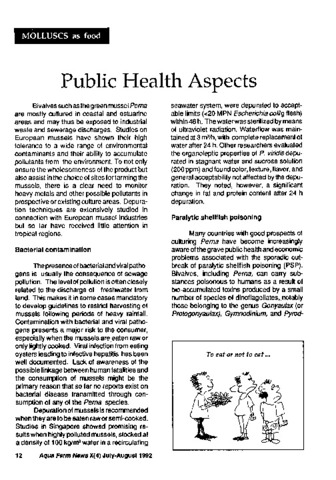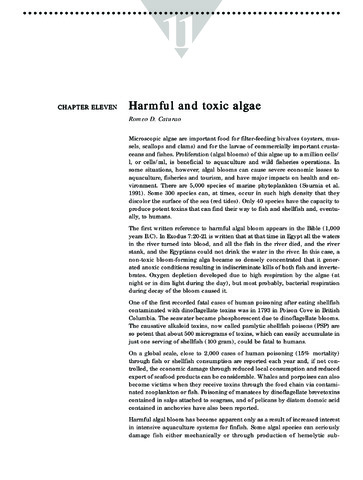Paralytic shellfish poisoning toxin accumulation in shellfishes collected from various habitats in Murcielagos Bay, Philippines during harmful algal blooms occurrence
- Global styles
- MLA
- Vancouver
- Elsevier - Harvard
- APA
- Help

Download URL
www.aensiweb.com日付
2014Page views
1,841ASFA keyword
AGROVOC keyword
Taxonomic term
Geographic names
Metadata
アイテムの詳細レコードを表示するShare
抄録
This study aims to determine whether the habitat of bivalves plays an influence in the occurrence of tropical shellfish toxicity during toxic red tide bloom occurrences in Murcielagos Bay, Misamis Occidental, Philippines. Various shellfish species were collected during the occurrence of red tide blooms. The type of habitat and the shellfish toxicities were investigated. Likewise, the phytoplankton profile in the seawater column was assessed. Results of our study revealed that the occurrence of shellfish toxicities was habitat specific in spite of the fact that the causative organism Pyrodinium bahamense var. compressum was present in low concentrations in the sampling sites. Shellfish collected from sea grass, coralline area, and seafloor habitats were notably susceptible against the paralytic shellfish poisoning toxin contamination compared to those samples obtained from soil substrate. Continuous monitoring of areas that are affected with shellfish toxicity must be conducted so as to safeguard the general public’s welfare dependent on these resources.
Keywords
Pyrodinium bahamense var. compressumSuggested Citation
Narceda, R. J. A., Montojo, U. M., Eguia, M. R. R., & Sia Su, G. L. (2014). Paralytic shellfish poisoning toxin accumulation in shellfishes collected from various habitats in Murcielagos Bay, Philippines during harmful algal blooms occurrence. Advances in Environmental Biology , 8(7), 2262-2265. http://hdl.handle.net/10862/2251
Type
ArticleISSN
1995-0756; 1998-1066Collections
- Journal Articles [1247]
Related items
Showing items related by title, author, creator and subject.
-
Evaluation of post-release behavior, recapture, and growth rates of hatchery-reared abalone Haliotis asinina released in Sagay Marine Reserve, Philippines
Lebata-Ramos, Ma. Junemie Hazel ; Doyola-Solis, Ellen Flor C.; Abrogueña, Jeff Bogart R.; Ogata, Hiroshi; Sumbing, Joemel G.; Sibonga, Rema
; Doyola-Solis, Ellen Flor C.; Abrogueña, Jeff Bogart R.; Ogata, Hiroshi; Sumbing, Joemel G.; Sibonga, Rema  (Taylor & Francis, 2013)
The lucrative returns brought by abalone fisheries have caused overexploitation and decline of the wild population. In the Philippines, the Aquaculture Department of the Southeast Asian Fisheries Development Center has ...1212 Total citations5 Recent citations1.43 Field Citation Ration/a Relative Citation Ratio
(Taylor & Francis, 2013)
The lucrative returns brought by abalone fisheries have caused overexploitation and decline of the wild population. In the Philippines, the Aquaculture Department of the Southeast Asian Fisheries Development Center has ...1212 Total citations5 Recent citations1.43 Field Citation Ration/a Relative Citation Ratio -
Public health aspects: Molluscs as food
Castaños, Milagros T.; Southeast Asian Fisheries Development Center, Aquaculture Department (Aquaculture Department, Southeast Asian Fisheries Development Center, 1992) -
Harmful and toxic algae
Caturao, Romeo (Aquaculture Department, Southeast Asian Fisheries Development Center, 2001)The chapter provides basic facts about harmful and toxic algae. It also discusses the conditions that stimulate their occurrence, different types of harmful and toxic algal blooms and their effects to fish and marine ...






